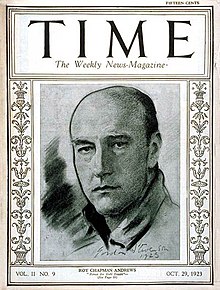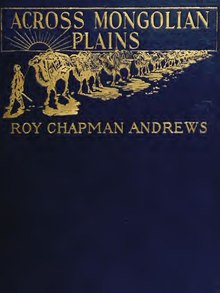Roy Chapman Andrews
Roy Chapman Andrews | |
|---|---|
field work | |
| Spouses |
|
| Awards | Cover of Time Magazine , October 29, 1923 |
Roy Chapman Andrews (January 26, 1884 – March 11, 1960) was an American explorer, adventurer and naturalist who became the director of the American Museum of Natural History.[1] He led a series of expeditions through the politically disturbed China of the early 20th century into the Gobi Desert and Mongolia. The expeditions made important discoveries and brought the first-known fossil dinosaur eggs to the museum. Chapman's popular writing about his adventures made him famous.
Biography
Early life and education
Andrews was born on January 26, 1884, in
Career

From 1909 to 1910, Andrews sailed on the USS Albatross to the East Indies, collecting snakes and lizards and observing marine mammals. In 1913, he sailed aboard the schooner Adventuress with owner John Borden to the Arctic. They were hoping to obtain a bowhead whale specimen for the American Museum of Natural History. On this expedition, he filmed some of the best footage of seals ever seen, though did not succeed in acquiring a whale specimen.
He married Yvette Borup in 1914. From 1916 to 1917, Andrews and his wife led the Asiatic Zoological Expedition of the museum through much of western and southern Yunnan, as well as other provinces of China. The book Camps and Trails in China records their experiences.
In 1920, Andrews began planning for expeditions to
Andrews, along with

In his preface to Andrews's 1926 book, On the Trail of the Ancient Man, Henry Fairfield Osborn predicted that the birthplace of modern humans would be found in Asia and stated that he had predicted this decades earlier, even before the Asiatic expeditions.[3]

On July 13, 1923, the party was the first in the world to discover
In 1927, the Boy Scouts of America made Andrews an Honorary Scout, a new category of Scout created that year. This distinction was given to "American citizens whose achievements in outdoor activity, exploration and worthwhile adventure are of such an exceptional character as to capture the imagination of boys...".[5] That same year, Andrews was elected to the American Philosophical Society.[6]
Andrews was President of The Explorers Club from 1931 to 1934. In 1934, he became the director of the Natural History museum. In his 1935 book
Association with character "Indiana Jones"

An analysis by the Smithsonian Channel concludes that the linkage was indirect, with Andrews (and other explorers) serving as the model for heroes in adventure films of the 1940s and 1950s, who in turn inspired Lucas and his fellow writers.[8][9]
Bibliography

Books listed on Worldcat:[10]
- Monographs of the Pacific Cetacea (1914–16)
- Whale Hunting With Gun and Camera (1916)
- Camps and Trails in China (1918)
- Across Mongolian Plains (1921)
- On The Trail of Ancient Man (1926)
- Ends of the Earth (1929)
- The New Conquest of Central Asia (1932)
- This Business of Exploring (1935)
- Exploring with Andrews (1938)
- This Amazing Planet (1939)
- Under a Lucky Star (1943)
- Meet your Ancestors, A Biography of Primitive Man (1945)
- An Explorer Comes Home (1947)
- My Favorite Stories of the Great Outdoors (1950)
- Quest in the Desert (1950)
- Heart of Asia: True Tales of the Far East (1951)
- Nature's Way: How Nature Takes Care of Her Own (1951)
- All About Dinosaurs (1953)
- All About Whales (1954)
- Beyond Adventure: The Lives of Three Explorers (1954)
- Quest of the Snow Leopard (1955)
- All About Strange Beasts of the Past (1956)
- In the Days of the Dinosaurs (1959)
References
- ^ a b "Dr. Roy Chapman Andrews Dies. Explorer and Naturalist Was 76. He Discovered Dinosaur Eggs in Asia in 1920s. Headed Natural History Museum". Associated Press in The New York Times. March 12, 1960. Retrieved February 18, 2014.
Dr. Roy Chapman Andrews, explorer and naturalist, died here tonight of a heart attack at Peninsula Community Hospital. He was 76 years old.
- ^ Horns, tusks, and flippers: the evolution of hoofed mammals, Donald R. Prothero, Robert M. Schoch p. 119, also see Men and dinosaurs: the search in field and laboratory, Edwin Harris Colbert
- ^ Chris Beard, Hunt for the Dawn Monkey, p. 307
- ^ "protoceratops".
- Time. August 29, 1927. Archived from the originalon February 20, 2008. Retrieved October 24, 2007.
- ^ "APS Member History". search.amphilsoc.org. Retrieved July 31, 2023.
- ^ "IMG_5930.JPG (2.23MB) - SendSpace.com". www.sendspace.com.
- ^ "Smithsonian Channel: Telling America's Stories". Archived from the original on February 2, 2013. Retrieved January 3, 2013.
- ISBN 0-312-10456-1., pp. 97–98
- ^ "Results for 'Roy Chapman Andrews' [WorldCat.org]". worldcat.org.
Further reading
- Dragon Hunter; biography by Charles Gallenkamp (2001)
External links
 Quotations related to Roy Chapman Andrews at Wikiquote
Quotations related to Roy Chapman Andrews at Wikiquote Media related to Roy Chapman Andrews at Wikimedia Commons
Media related to Roy Chapman Andrews at Wikimedia Commons- Roy Chapman Andrews Society official website
- Works by Roy Chapman Andrews at Project Gutenberg
- Works by Roy Chapman Andrews at LibriVox (public domain audiobooks)

- Works by Roy Chapman Andrews at Faded Page (Canada)
- Works by or about Roy Chapman Andrews at Internet Archive
- Roy Chapman Andrews at Find a Grave
- 1929 Popular Mechanics article about Andrews expedition to Mongolia
- This Business of Exploring Manuscript at Dartmouth College Library
